#kosher food
Text
Jewish recipes: Bakhsh
I often make this as a meal prep situation so I make a large dish and then we have it for lunches/dinner during the week. Or for Shabbat. This is a Bukharian Jewish dish called Bakhsh, which is a simple dish of rice that's cooked with tons of herbs, usually cilantro and dill, and with meat (most traditional is lamb iirc). I can't get kosher lamb easily where I live at all, so mine is always chicken and it's made in a glass baking dish in the oven.
Bakhsh (green rice)
Ingredients:
2 cups rice (I always use short grain bc that is what we have on hand), washed/rinsed, uncooked
4 whole bunches fresh cilantro (or 3 + 1 fresh parsley -- can also add a bunch of fresh dill if desire), chopped
1 cup cubed meat of choice (I always use chicken breast), uncooked
1 diced yellow onion
1/2 c oil (I use avocado)
1/2 c water
1 tbsp salt
1 tbsp chicken consomme powder (I use the Osem brand)
Ground black pepper, cumin, turmeric, and coriander to taste
Instructions:
Line glass baking dish w/parchment paper.
Combine all ingredients in the dish, stir well. Cover with foil.
Bake covered at 400F for 45 minutes, then remove and stir well. Re-cover and bake for 45 more minutes.
Enjoy! The favorite part of this dish in my house is the brown crust that forms on bottom, similar to what we call 누룽지 (nurungji) in Korean (it's the scorched rice I guess that forms on the bottom of the stone pot) -- it's so tasty and crunchy!
#jewish food#jewish recipes#food#jumblr#jewish#recipe#bukharian jewish food#kosher#kosher food#kosher recipes
297 notes
·
View notes
Note
Jewish culture is being really confused about what the fuck is kosher salt, all salt is kosher unless you grate some pork or shrimp or whatever on it. I’m so confused do goyim just think that kosher means plain or something???
kosher salt is bigger flakes!! I don't know why it's called kosher salt, but I think it's something to do with how it's usually used for like... koshering meat? I think?
136 notes
·
View notes
Text
There's a special kind of irony in me, a pagan, preparing kosher food so my Jewish brother-in-law will have something to eat at my family's Christmas potluck.
#to be clear: the christian family members are also cooking kosher food#this is about interfaith solidarity around cozy holiday gatherings#not bad christians (thankfully)#interfaith#interfaith family#christmas#yule#pagan#paganblr#witchblr#witch#kosher food#mine
205 notes
·
View notes
Text
An Introduction to Kashrut & Kosher Eating

i. "Kashrut" and "Kosher"?
ii. Kashrut Specifics
iii. Modified Ways to Keep Kosher
iv. Resources
border inspo & header art

You may already be confused about what these words even mean, and that's totally okay, we're all here to learn. The following are some important terms to keep in mind:
Halakha : Jewish Law as outlined within the Talmud. It governs everything from punishment for crimes to sex to defining "what" Judaism is. It is more of a way of life than a set of laws.
Kashrut : A subsection of Halakha, specifically referring to regulations surrounding food and everything to do with it.
Kosher : An adjective used to refer to food or food-related products (like forks and spoons) that are deemed okay for Jews to eat/use by Kashrut. "Keeping Kosher" refers to eating according to Kashrut.
Kashering : To cause something to become kosher.
Treif : Everything that is non-Kosher.
Pareve : Food that is "neutral", neither meat nor dairy. This includes fruits, vegetables, grains, eggs, and sometimes fish.
Kashrut tells us what animals are safe to eat, how these animals should be slaughtered, what food can and can't be mixed, alongside instructions on how to use the tools made for preparing/eating food. There's a lot more to Kashrut (which I'll go into soon), but those are the basic ideas. Kashrut includes many guidelines that we see as common sense (such as not eating diseased meat) to everyday cleanliness (checking that fruits and veggies are free of bugs) to things that some people would think are "weird" (like not eating shrimp).
Of course, much of Kashrut is highly cultural in nature, and was largely shaped by Jewish cultural ideas of cleanliness and commonly eaten foods. Some animals may be a normal part of the cultural in many countries/cultures, but they are not Kosher, as Israelites never included such things in its food. This is why many Jews who are also parts of cultures to whom treif foods are significant experience a lot of inner conflictions about keeping Kosher. Instances like the one mentioned before, alongside a countless amount of others, are why there are different levels of keeping Kosher, which I will expand on soon.
Many people ask me why I eat Kosher in the first place. Reactions range anywhere from "Oh wow, I could never give up bacon!" to "Ugh, why follow such archaic laws?" when people find out.
But really, why do we? Is it because it would cause severe health issues if we ate shellfish or a ham and cheese sandwich? No, obviously not. While some of the prohibitions in Kashrut may have health benefits, such as avoiding certain diseases or infections, the primary reason for observing these laws is not based on health concerns. In fact, Halakha dictates that we should not eat Kosher if it would threaten our health or lives in any way. We live by the laws, we don't die by them.
Interestingly enough (right back at ya, "archaic laws" person), it's because they are archaic. It is not because anyone who eats pork is disgusting or wrong or bad in any way. It's our culture, our tradition, it's been passed down for absolutely forever. It's a marker and a reminder of who and what we are, a way to celebrate Jewishness. It's also a ritual, a daily form of active mediation and prayer to bring us closer to (and remind us of) HaShem.
Eating Kosher is not just about what we eat, but also about how we eat. It's a daily ritual that involves mindfulness, intentionality, and gratitude. It's a way to incorporate our culture and religion into our every day, never forgetting who we are. By following these ancient guidelines, we affirm our connection to a long and rich history, to a community that has survived and thrived through centuries of persecution and adversity.
We embrace a way of life that is not driven by the latest trends or fads, but rather by timeless values and principles that have stood the test of time. When we follow the laws of Kashrut, we are reminded of our connection to HaShem, the sanctity of our traditions, and the importance of our community.

Alright, now it's time to get into the exact specifics of what Kashrut outlines for us. It is usually Orthodox Jews who follow every single one of the rules, Conservative Jews follow most(ish) of these rules, and Reform Jews tend to not keep kosher. Of course, this doesn't speak for all denominations or even every Jew in each of the denominations I mentioned, but those are the most common "levels" of keeping kosher among Jews. Keeping kosher is hard, and not everyone has the time, resources, etc. to follow Kashrut as closely as they'd like, which is why different people choose what's right for them.
In this section, I'll cover the exact guidelines in Kashrut, exceptions to keeping kosher, and some modern interpretations of kosher expectations.

Anything produced by forbidden animals- like their eggs and milk- is prohibited.
Land mammals should have cloven hooves and chew their cud.
— In Leviticus 11:3 and Deuteronomy 14:6
— Cloven hooves: Hooves split into two "toes".
— Chewing cud: The process of chewing, partially digesting, regurgitating, and re-chewing food.
— Permitted land mammals include oxen, goats, sheep, and deer.
— Forbidden land mammals include pigs, horses, rabbits, and camels.
Marine life must have fins and scales.
— In Leviticus 11:9 and Deuteronomy 14:9
— Permitted marine life includes salmon, tuna, and carp.
— Forbidden marine life includes shrimp, lobster, and scallops.
Birds must not be scavengers or birds of prey
— In Leviticus 11:13-19 and Deuteronomy 14:11-18
— Only specific birds are prohibited, not types of birds. Rabbis have decided to forbid the categories the listed birds fall into (scavengers and birds of prey).
— Permitted birds include chicken, geese, ducks, and turkeys.
— Forbidden birds include eagles, vultures, ravens, and owls.
Winged insects are… complicated.
— In Leviticus 11:22
— Some winged insects used to be permitted, but we no longer know which ones those are, so all winged insects are decidedly forbidden.
— Interestingly enough, Yemini Jews have very very old traditions of identifying and eating certain locusts as kosher animals. This could be an echo of our now lost outlines on what insects are, in fact, kosher. How cool is that?
Other miscellaneous animals are forbidden.
— In Leviticus 11:29-30, 42-43
— Rodents (mice, squirrels, rats)
— Wingless insects (centipedes, silverfish, lice)
— Amphibians (frogs, toads, salamanders)
— Reptiles (snakes, lizards, turtles)
Certain parts of kosher animals are forbidden to eat.
— All blood from the meat of land mammals and birds must be drained out during slaughter and then salted/broiled out because blood is their life force and should be respected (Leviticus 7:26-27; 17:10-14).
— Fat found on on the internal organs and below the eleventh rib (Leviticus 3:9; 7:23).
— The sciatic nerve (of the lower leg) to commemorate Jacob’s victory over an angel after they wrestled all night, during which the angel dislodged Jacob’s sciatic nerve (Genesis 32:22).
Animals must be slaughtered in a particular way.
— In Deuteronomy 12:21; 14:21 and Numbers 11:22.
— These rules pertain to land mammals and birds, but not fish.
• Animals cannot have died due to natural causes or another animal killing them.
— Meat should not be diseased or flawed in any way.
— Animals must be slaughtered by having their throat slit quickly and in one strong slash. This way, the most blood drains out and the animal is slaughtered in the most humane way.

Meat and dairy cannot mix (Exodus 23:19; 34:26 and Deuteronomy 14:21).
Foods which are neither meat nor dairy are pareve, and can be used freely with both meat and dairy.
— Commonly, fish is counted as pareve, but some traditions (usually Sephardic) prohibit the mixing of fish with meat.
A certain amount of time should pass between the consumption of meat and dairy.
— Traditionally, one waits 3-6 hours after eating meat to consume dairy, but only 1-3 hours after eating dairy to eat meat.
— Some traditions include that one must wait only an hour after dairy, except for hard cheeses, after which they must wait 3 hours.
Different utensils and equipment must be used for meat and dairy. This includes everything from the tools used for slaughter to the plates in your home.
— Utensils have a label just like food (meat, dairy, pareve, or treif) which affects the status of the food which comes in contact with it, but only in the presence of heat.
— For example, a fork will become treif if it touched shrimp, and if it touches any hot kosher food (or if the fork or shrimp is hot), the food also becomes treif. This affects things like dishwashers (in which both meat and dairy utensils come in contact with heat in the same space), sinks (which can be hot), and towels (when used to transport hot pots).
— It is totally fine to do something like use a knife with both meat and dairy, as long as both the knife and food is cold, and as long as the knife is cleaned between foods.

All fruits and vegetables are kosher.
— In Genesis 1:29
— Fruits and vegetables must be thoroughly washed and checked for bugs.
— Fruits and vegetables cannot come in contact with any products which include insects, like some dyes and additives.
Grape products cannot be made by idolators.
— This began because of wine's ritual importance, and Jews did not want to consume wine that was made to use in the worship of idols.
— This usually only refers to wine or grape juice.
— More recently, because the creation of wine is now automated, it is technically not made by idolators and has been seen as kosher to some denominations (usually Conservative Jews).

We've gone through the different rules and regulations of Kashrut, which include that utensils/towels can become treif. But what happens if you accidentally eat treif? If utensils become treif, do they need to be thrown out?
Accidentally (or knowingly) eating treif.
— The remedy for this is simply to feel bad and do better in the future.
— But, if you feel particularly bad, you can do a good thing so that the bad thing (eating treif) leads to a good thing, and therefore the entire mistake becomes positive. Good things can include tzedakah, charitable giving (like donating money/old clothes, volunteering, etc.).
Kashering utensils, equipment, etc.
— Kashering is done both when something is first bought and if it ever becomes trief. Usually, only new cooking equipment is kashered (like by being dipped into a mikveh, a pool of holy water), and not everything you buy.
— To "reset" utensils/equipment after it has become treif, it can be dipped in a mikveh, or things like towels can be kashered simply but putting them in the laundry.
— Everyone will have different ways to kasher and different intensities of kashering.
Treif food being the only option.
— During medical emergencies (like a blood sugar crash) or similar situations, it is not a sin to eat treif. Human life is put above all else within Judaism, meaning that everything will be rendered not a sin if breaking it is necessary to save a life (which is also why abortion is required even in the most Orthodox communities).

Keeping kosher is hard. There's a ton of rules and things which build upon each other. It's a lot to remember. Considering that many households separate meat and dairy to the point of having separate sinks and refrigerators, most people just don't have the resources to keep kosher in that way.
If you're low on spoons, disabled, or neurodivergent, those factors can make keeping kosher even more difficult. I'm a spoonie with ADHD and Autism, so I'm chronically fatigued, and have ARFID that contributes to multiple food-related issues.
You should always remember that you are not required to keep kosher if it interferes with medical needs (like I listed), and so you should never feel bad about how "well" you keep kosher. That being said, let's move onto some tips for modified kosher eating.
Try only keeping kosher on shabbat and/or important holidays.
Sometimes, our safe foods or the only food we have access to are treif. However, you're usually already listening to 99% of Kashrut prohibitions on which animals you can eat (like avoiding bugs, reptilians, rodents, scavengers, etc.). So that's already a big step!
Instead of having completely separate equipment for meat/dairy, simply wash your utensils between using them for meat/dairy.
Instead of waiting up to 6 hours between eating meat and dairy, wait 1 hour, drink water between the two foods, and/or create a distinct separation in time between consuming the foods (like getting up to go do something, stopping to talk, etc.).
When it comes to washing utensils, try and separate them by putting them on different washing machine racks, run the washing machine between using it for meat/dairy utensils, or rinse off the inside of the sink between hand-washing meat/dairy utensils.
Use disposable plates/cups/utensils to separate meat and dairy.
Buy only kosher meat, or only kosher foods (most foods in everyday grocery stores will be kosher).
If you're vegan, and depending on the type of vegetarian, you're already eating kosher!

You've finally reached the end of this post, and I hope it was helpful to you. Below, I will list multiple sources for further reading, help in keeping kosher, and just some cool questions about being kosher ("is meat from a cloned animal kosher?").
An extensive course on the laws of Kashrut taught by Rabbis
"Bagels: A Surprising Jewish History" by Dr. Yvette Alt Miller
"Does G-d Really Care?" from Kosher Certification
"I Keep Kosher. My Parents Did, Now Don't. It's Complicated." by Talia Kaplan
"Is Lab-Grown Meat Kosher?" by Yehuda Shurpin
"Issues in Jewish Ethics: The Ethics of [Kosher] Cloning" by Dr. Daniel Eisenberg, M.D.
"Jews in America: The Kosher Meat Boycott of 1902" by Dr. Michael Feldberg
"Kashrut Laws as Written in Torah" from the Jewish Museum in London
"Kashrut: the Jewish Dietary Laws [from Biblical, Rabbinic, and Modern Perspectives]" by Jonathan Magonet
"Marijuana Is Always Kosher, as Long as You Smoke It" by Ruth Schuster
"OU Kosher Grocery Store Symbols Explained" by Rabbi Chaim Goldberg
"People Eat Treyf for Their Own Reasons. They All Think About Their Judaism." by Jonathan Katz
"Saying Goodbye to Bacon" by Liel Leibovtiz
"Ten Reasons to Keep Kosher (And They’re Not What You Think)" by Rabbi Alec Goldstein
"The Jewish Dietary Laws: Their Meaning for our Time and a Guide to Observance" by Samuel H. Dresner and Seymour Siegel
"The Rules for Kosher Creepy-Crawlies" from Sefaria
"What Archaeology Tells Us About the Ancient History of Eating Kosher" by Lina Zeldovich
"What Is Kosher for Passover?" from Chabad.org
"Why I Don’t Keep Kosher" by Rabbi Jillian Cameron
"Why I Stopped Freaking Out About Other People’s Kosher Habits" by Erris Langer Klapper
"Why Keep Kosher?: Jewish dietary practices allow us to welcome the sacred into our daily lives and into mundane acts." by Rabbi Dr. Bradley Shavit Artson
"5 Misconceptions About Keeping Kosher" by Mandy Hakimi

#judaism#jewish#jumblr#jewblr#jewish culture#pesach#passover#kosher#kashrut#torah#talmud#shabbat#jewish life#kosher food#halakha#yeshivawithcarver#references
432 notes
·
View notes
Text
I messed up budgeting this month, while I'm not completely broke there wasn't anything left for fresh fruit or veggies. I live in a community with Jewish food pantry that serves neighbors from all walks of life (Jewish or not) including kosher clients. I'm blown away by how much good fresh food they gave me and how friendly everyone was. They didn't bat an eye at knowing what I could actually cook since I have only a Dairy kitchen. They even had special Rosh Hashanah bags with apples, honey, frozen challah, and candles! If you're genuinely struggling to afford the holidays check with your local Jewish Federation/JCC/Shul/JCFS and see if they can point you to a food pantry that can help.

#jumblr#jewish#kosher#kashrut#seriously just go if you think you need the help you probably do#food pantry#kosher food#food bank#kosher food pantry
156 notes
·
View notes
Text
Last night I made Bakhsh! It's a Bukharian rice with meat, onions, and loads of cilantro. I used the recipe from @pomegranateandhoney and it was amazing! We used lamb and increased the amount of meat in the recipe, as my family is very into meat. It turned out delicious and we enjoyed it a lot. I made a little Israeli salad to go with it.


#citrus.txt#citrus cuisine#jumblr#jewish cooking#jewish food#cooking#home cooking#jewish joy#jews on tumblr#kosher food#bakhsh
32 notes
·
View notes
Text
“Wow, it must be so hard to keep kosher if you didn’t grow up with it!”
And I always feel sweat on the back of my neck, nodding, even though one exam season I survived off of cupcake frosting, coffees, protein bars, and a peanut butter jar (for protein).
“Well,” i say, very seriously. “Somehow that hasn’t been the biggest roadblock.”
#fromgoy2joy thoughts#I just needed to pass the anatomy exam#I just had midterms and ate real food don’t worry. I’m better now#IM A CHANGED WOMAN#jumblr#jewish#jewish convert#jewblr#jewish tumblr#jewish conversion#jewish humor#kosher food#the challenge is eating food in the first place#is this why Jewish people have stomach problems?
25 notes
·
View notes
Text
Questions for religious Tumblr based on convo with moots.
My sona Fluffy is a shark with lycanthropy.
Would eating him on a friday break the rules of lent?
Would he be Kosher?
Would he be Halal?
This is genuine curiousity and very much an invitation to cultural exchange regarding these rules using this as a jumping off point.
#fluffylandshark#shark posting#question for tumblr#religion#Islam#judaism#catholiscism#lent#halal food#kosher food
26 notes
·
View notes
Text
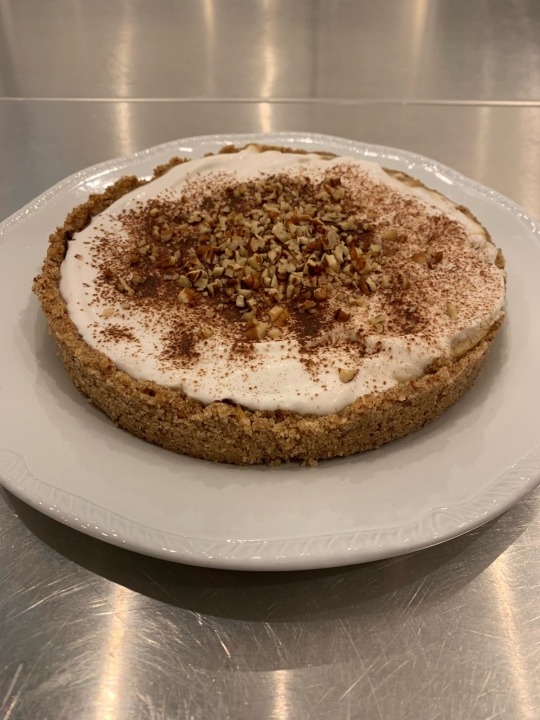
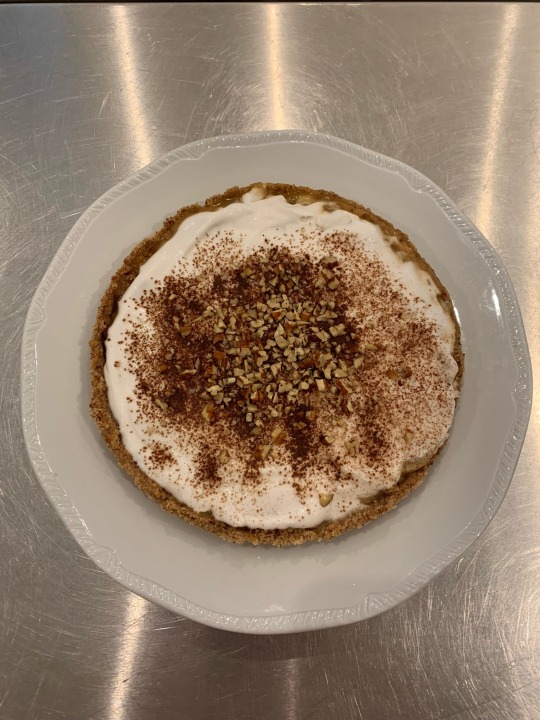

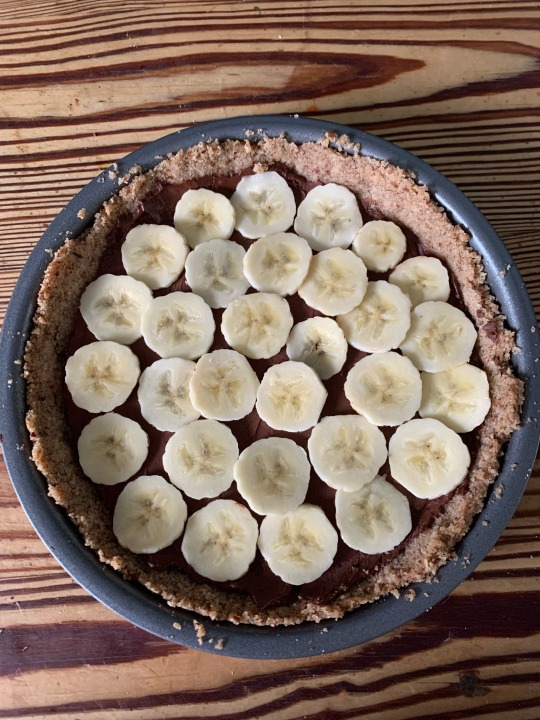


Vegan Passover Pecan-Banoffee Pie: my magnum opus
I set out with a dream. An impossible dream. To create a vegan dessert for my synagogue seder that was also kitniyot-free. Did I have to do this? Not really, my shul allows anything vegan, vegetarian or pescatarian that doesn’t have chametz, and we have a section for kitniyot. Am I vegan? No. Do I even keep kosher for Passover myself? Also no. But, you see, I have an almost pathological need to feed as many people as possible, and I am intractably stubborn, so once I realised how difficult this was going to be it only made me dig my heels in further.
It turns out to be borderline impossible to find vegan substitutes for pretty much anything that don’t contain soy, oats, cornflour, chickpeas, or some sort of forbidden legume. Subsequently this recipe is heavily reliant on coconut milk; luckily for me I live in an area with a large Muslim population and it’s currently Ramadan, so tins of coconut are front and centre of every supermarket display.
It’s taken almost a full month of trial, error and meltdowns in the butter aisle of Sainsbury’s, but I finally did it. I had to cobble bits of the recipe together from half a dozen different sources, so I feel relatively justified in calling this my own invention. The pecan crust is borrowed from a Tori Avey cheesecake recipe, I just swapped pistachios for pecans. I really think the crust is what makes it, to be honest. You could probably skip the ganache layer if you can’t be bothered, I just feel like it helps cut through the sweetness.
Recipe under the cut. Please please tag me if anyone decides to make this! I would be so delighted to see it out there in the world.
Crust
84g (⅔ cup) pecans
84g (⅔ cup) pecans
84g (⅔ cup) pecans
60g (½ cup) matzo meal
66g (⅓ cup) granulated sugar
71g (5 tbsp) Kosher for Passover vegan margarine (Rakusen’s Tomor*), melted, + extra for greasing
Pinch of salt (optional)
Ganache
113g KFP vegan dark chocolate (Lindt Excellence 70%, Green & Black’s 70%, Green & Black’s cooking chocolate are all KFP)
113g coconut cream/full-fat coconut milk
A few drops of vanilla extract (optional)
Caramel
200g caster sugar
100g KFP vegan margarine (Tomor)
200g coconut cream/full-fat coconut milk
Whipped cream
200g coconut cream/full fat coconut milk, kept in the fridge overnight
15-45g KFP icing sugar (check it doesn’t contain maize starch. You could probably omit the sugar and leave the cream unsweetened if you can’t find it, or grind your own- there are recipes for Passover powdered sugar online.)
¼ tsp vanilla extract
3-4 bananas
cocoa powder or grated chocolate to serve (optional)
chopped pecans to serve (optional)
Method
Make the caramel. Place the sugar into a medium / large saucepan. Place the pan on the hob over a low heat. Allow the sugar to melt, this will take around 5-8 minutes. Don’t burn the sugar! Make sure to stir constantly to prevent burning. You can use a wooden spoon or heat proof spatula.
When all of the sugar has melted and is a golden / amber colour, add in the margarine. Be careful, as the sugar is very hot. Remove the pan from the heat and stir to combine. Allow the margarine to melt into the sugar. It might bubble but that's fine. Once it’s combined, it might have a thick consistency. It might look like the margarine isn’t mixing with the sugar, but it should combine once you add the cream. Now add in 200g coconut cream. It will steam and bubble again so be careful.
Add the pan on the heat and allow to simmer for 3-5 minutes to help thicken it up.
Remove the pan from the heat. Set aside to cool for 30 minutes, then transfer / pour the caramel into a heat proof jar. Place the jar into the fridge. Allow to chill overnight. The coconut cream for the whipped cream should also be kept in the fridge overnight, to encourage it to separate and firm up.
If the caramel separates overnight, use an electric whisk to combine into a smooth consistency until there are no remaining lumps. It’ll be a more custard-like texture but still delicious. Keep caramel in the fridge until needed.
Make the crust. Preheat oven to 180˚C. Grease a loose-bottomed tin with margarine and line with greaseproof paper.
Blitz the pecans in the food processor until finely processed. Add matzo meal, salt and sugar and pulse until the entire crust is uniform in colour. With the processor on, drizzle the melted butter into the machine.
Once all the butter has been added, turn the processor off and dump the wet crumbs into the bottom of the lined pan. Using the back of a spoon, press the crumbs evenly into the bottom and up the sides of the pan (it doesn’t have to go all the way up, just as much as you can).
Place the crust in the oven for 8-10 minutes, or until the edges of the crust start to brown a bit and smells fragrant. Leave crust to cool for about ten minutes and then transfer to the fridge to finish cooling.
Make the ganache. Finely chop the chocolate and put in a medium-sized bowl. Put 200g coconut cream in a microwave-safe bowl and heat in the microwave for about 1 minute, watching to make sure it doesn’t bubble over.
Pour the warm cream over the chocolate chips and let sit for 2-3 minutes. Don't stir yet.
After 2-3 minutes, whisk the chocolate/melted coconut milk until smooth. Add vanilla if desired. Let cool in the fridge for around 30 minutes.
Make the whipped coconut cream. Chill a mixing bowl in the fridge for ten minutes (you can do this while the ganache is cooling to save time). Put 200g coconut cream (the thick white part, not the clear liquid) in the chilled bowl. Beat for 30 seconds with an electric whisk until creamy. Add vanilla and icing sugar and mix until creamy and smooth – about 1 minute. Avoid overwhipping because it can cause separation. Taste and adjust sweetness as needed.
Carefully run a knife around the edge of the crust tin and remove the crust from the tin.
Spread a layer of the cooled ganache over the bottom of the crust. Top with a layer of sliced banana and return to the fridge to set for ten minutes.
Add a layer of the caramel, another layer of sliced banana, and return to the fridge for ten minutes again.
Top with the whipped cream (I like to leave the edge of the bananas visible around the edge). Dust with cocoa powder or grated chocolate and add chopped pecans if desired.
*Tomor contains sunflower oil, but sunflower oil is not considered kitniyot in England: https://www.kosher.org.uk/article/sunflower-oil-kitniyot
#Passover recipe#pesach 5783#pesach 2023#pesach recipe#passover#Passover 5783#Passover 2023#Passover food#pesach food#פסח 5783#פסח#פסח שמח#jumblr#judaism#jewish#jewish food#kosher#kosher food#kashrut
76 notes
·
View notes
Text
Are the Andalites from Animorphs Kosher? Like to eat? Could you eat one if you are Kosher? Obviously not with milk, but otherwise could you eat one of the Andalites from Animorphs and keep Kosher? Are they Halal???
15 notes
·
View notes
Text

Babe wake up you’ve barely touched your kosher beans.
64 notes
·
View notes
Text
recipes i'm going to make this pesach:
sweet & sour braised roast (i've a kalakel cut so that is what i'll be using)
olive oil mashed potatoes
apple matzah kugel
... and the leftovers on these will keep us fed the whole time, basically, as it's just my partner + me. but i'm also planning to make
matzah "chilquiles" one day for breakfast :)
and moroccan paprika fish because i cherish my once a week fish allowance during pregnancy like nothing else.
42 notes
·
View notes
Note
Idk if this fits the theme of the blog, but I figured you might find it funny.
I'm not Jewish, nobody in my family is Jewish (or of any religion), but my mom's roommate in college (in the 70's) was Jewish. Because of that one person, 50 years ago, my entire family keeps a kosher organized refrigerator, and my mom makes comments on every meal of whether or not it's kosher. She also goes out of her way to cook in ways that are kosher, I'm honestly not sure why, but growing into an adult I've found myself doing it as well without noticing.
it doesn't exactly fit the blog theme, but you're right, I do find it funny, so I'll post it anyway :3
37 notes
·
View notes
Text

Signature Select almond butter filled pretzel nuggets:
OU kosher!
13 notes
·
View notes
Text
Is it kosher to eat a dish with both edamame and tofu in it?
Tofu is made from soy milk, and edamame is just another name for soybeans, so does it count under "cooking a calf in its mother's milk?"
My roomate poised this question after I made a dish for the other roommate. I can't stop thinking about it, and my head hurts.
#kosher#jewish#judaism#tofu#soy#soybeans#soy cheese#kosher food#edamame#rediculous#dinner conversation
15 notes
·
View notes
Text
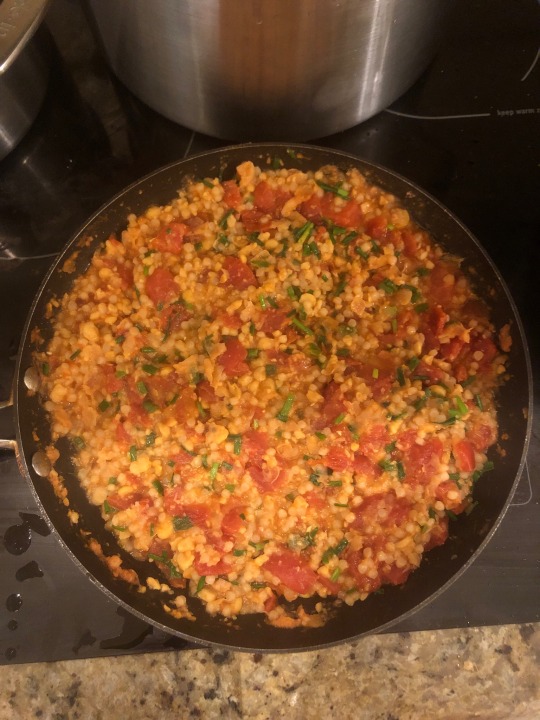
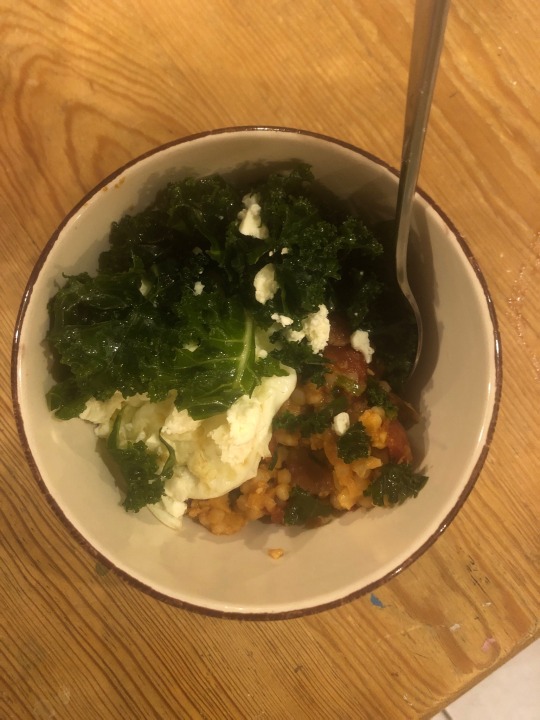
dinner i made on tuesday! it was israeli couscous in a chickpea & tomato sauce. we served it with a kale salad, feta, and runny fried eggs. absolutely delicious and the first vegetarian meal i've made! i got the recipe from pinchofyum.com. feel free to send an ask or dm me for the link!
#citrus.txt#citrus cuisine#jumblr#jewish cooking#jewish food#jewish joy#cooking#home cooking#jews on tumblr#kosher food
20 notes
·
View notes